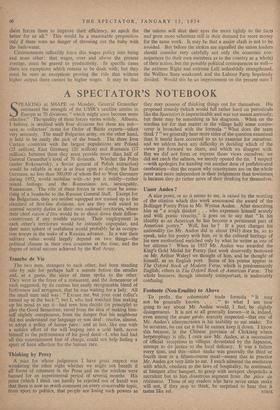A SPECTATOR'S NOTEBOOK
SPEAKING at SHAPE on Monday, General Gruenther estimated the strength of the USSR's satellite armies in Europe at 70 divisions, " which might soon become more effective." The 'quality of these forces varies widely. Albania, 1 believe, is credited with four divisions but these are not— save as collectors' items for Order of Battle experts—taken very seriously. The small Bulgarian army, on the other hand, is held to be easily the pick of the bunch. The three Iron Curtain countries with the largest populations are Poland (25 million), East Germany (20 million) and Rumania (17 million); between them they must provide more than half of General Gruenther's total of 70 division. Whether the Poles (under Rokossovsky, a Soviet general of Polish extraction) would be reliable in war is at least open to doubt; the East Germans, no less than 300,000 of whom fled to West Germany during 1952, would mobilise with---.-to put it mildly—rather mixed feelings; and the Rumanians are, inescapably, Rumanians. The role of these forces in war must be some- thing of a headache to the Russian General Staff. Except for the Bulgarians, they are neither equipped nor trained up to the standard of first-line divisions, nor are they well suited to internal security duties in their own national territories, where their chief raison d'être would be to shoot down their fellow- countrymen if any trouble started. Their employment in each other's territories would be intensely unpopular, and their main sphere of usefulness would probably be as occupa- tion troops in the wake of a Russian advance. In a war their military value would largely depend on two things—the political climate in their own countries at the time, and the degree •of initial success achieved by the Red Army.


































 Previous page
Previous page